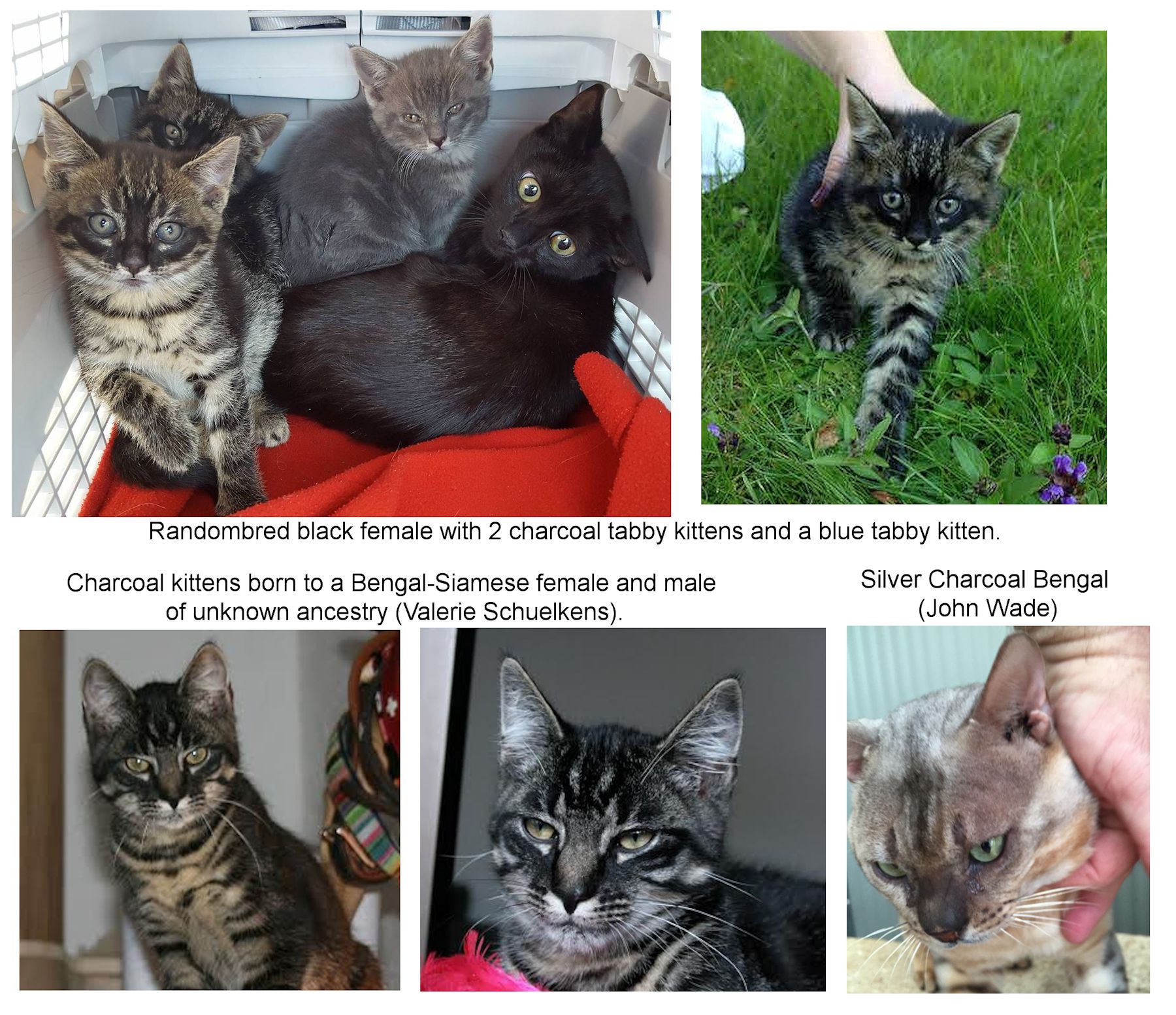
PSEUDOMELANISM AND CHARCOAL-LIKE PATTERN IN NON-BENGAL CATS
Over the years several cats with a "charcoal-like" pattern have appeared on Facebook cat genetics groups. In 2024 I was asked to collate images and information to aid further study. As a group, the best descriptive term is "pseudomelanism" which means the markings are unusually dense and coalesce to form areas of solid black. One or two of the cats may be chimeras where a genetically tabby fertilised egg and genetically solid colour fertilised egg have fused and formed a single embryo. Others are what some Bengal breeders call "sheeted tabbies" - heavily marked marble pattern cats. Some seem to be black smoke - genetically solid colour - with "breakthrough patterns." An example of breakthrough pattern is the smoke Egyptian Mau which is selectively bred to have black markings on a smoke background.

Above are examples of the true charcoal pattern, a form of partial melanism/abundism that darkens the back, giving the appearance of a black cape along the back and a zorro mask on the face with white goggles around the eyes. The "charcoal mask" runs from the forehead, down the nose-bridge and often underneath the eyes and extending into the mascara-lines to create an upside-down "Y". It is caused by an agouti gene inherited from the Asian Leopard cat when it combines with domestic cat genes. Abundism (pseudomelanism) also occurs in cheetahs (king cheetahs), leopards and jaguars where it turns the normal spotted pattern into thick swirls or merged rosettes. In domestic cats it commonly produces an almost solid colour face with pale curved areas above the eyes and a dark chest with thin pale necklets (reverse of the normal pattern). The body markings are denser, obscuring the background colour. As at 2024, the gene involved in pseudomelanism in domestic cats had not been identified, but appears to be something that affects the normal tabby marking genes.
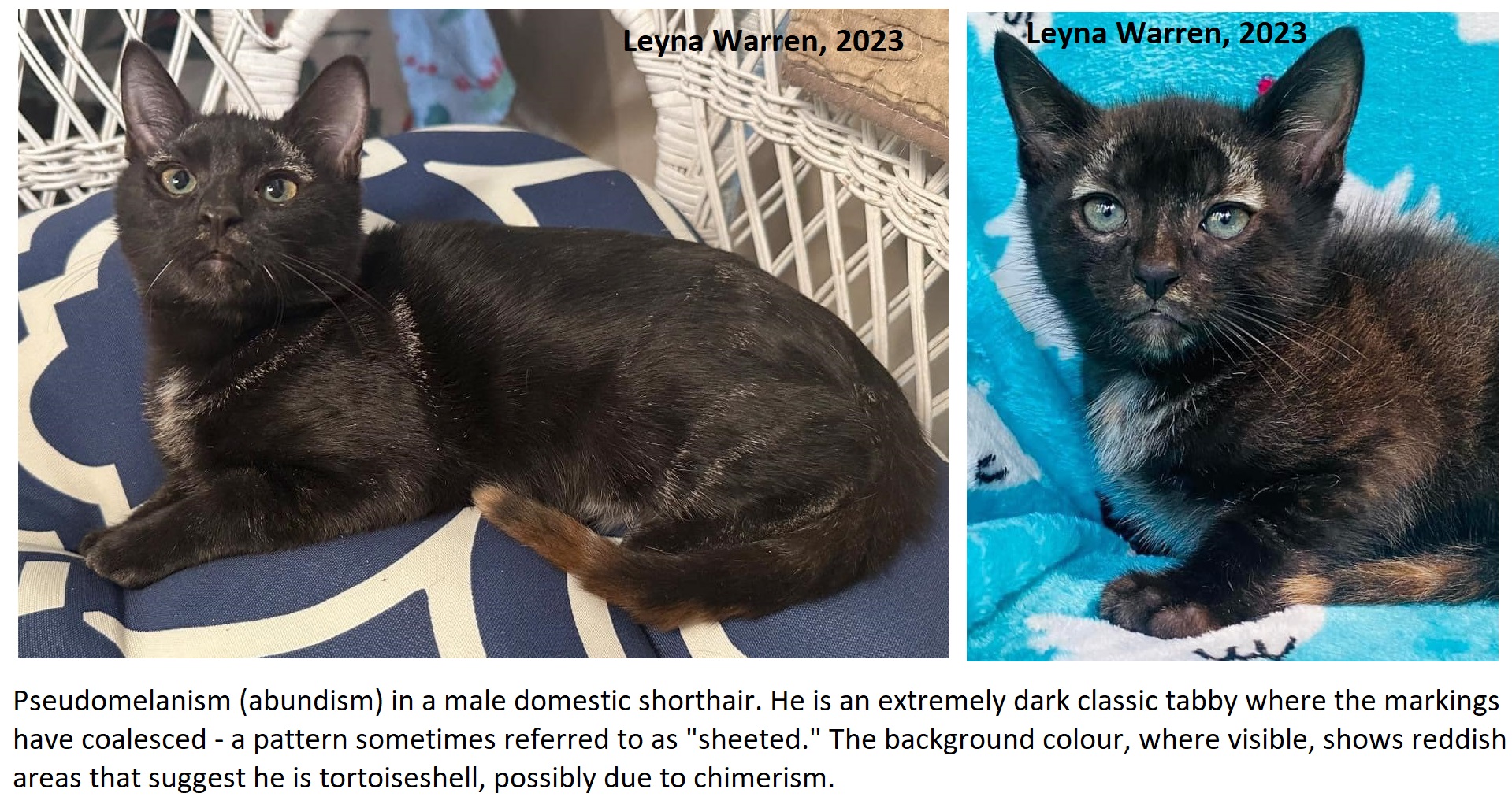
Most of the cats are black tabbies, these being most noticeable due to the colour contrast. The background colour is either tawny or greyish. Those with tawny background colour can resemble tortoiseshells with brindled fur. The dark grizzled background colour of others is somewhat reminiscent of the grizzle colour seen in Chausies, but with solid markings heavily overlaid on it.

Some of the pseudomelanistic cats are Oriental Shorthairs. Some are non-pedigree cats with a similar conformation. This has led to suggestions of a link to Bengals since the Oriental was used in Bengal breeding and some offspring may have got back into the Oriental Shorthair gene pool. Another suggestion is that unneutered pets with Bengal ancestry introduced the Asian Leopard Cat's AsipPb mutation into random-bred cats. Others resemble local random-bred cats and have no linked to Orientals or Bengals, such as Ba'lam, a rescue cat from Guatamala.
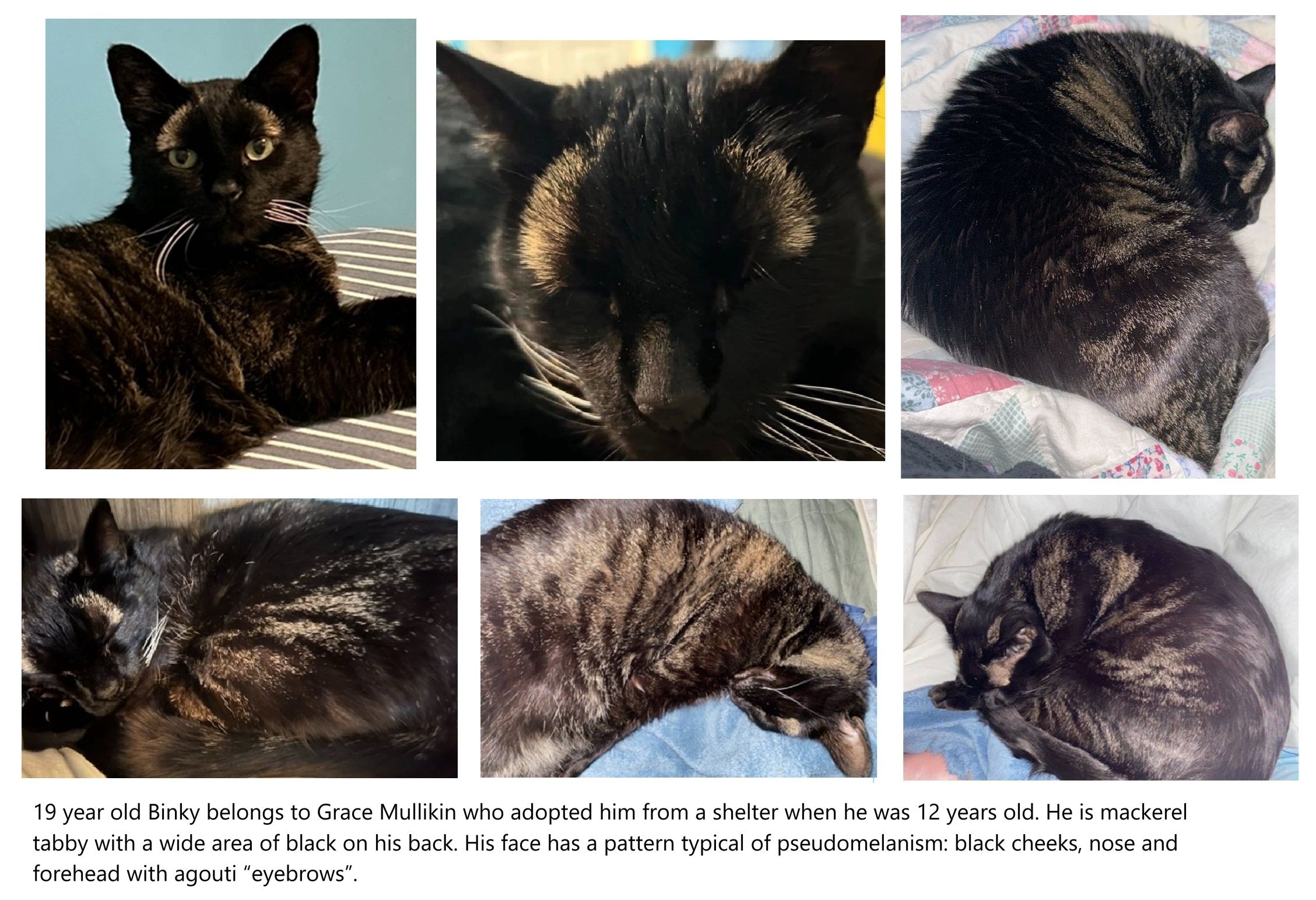

Caroline Callison Tiffin has a pseudomelanistic cat named Ba'lam (which means Jaguar in the Mayan language Kakchiquel). She adopted Ba'lam from a friend who had rescued him several years earlier in Guatemala. Caroline brought him to the United States and has no idea what his parents or littermates may have looked like. When she first saw photos of him he appeared to be a black-and-orange tortoiseshell and her friend thought Ba'lam was female. When she met him in person, she that he was male and was black on a silvery-grey background colour. He has tabby-like striping that was unlike any tabby pattern she had ever seen and he was predominantly black. He also does not have a visible "M" on the forehead. His body shape is very sleek and athletic and reminiscent of an Abyssinian.
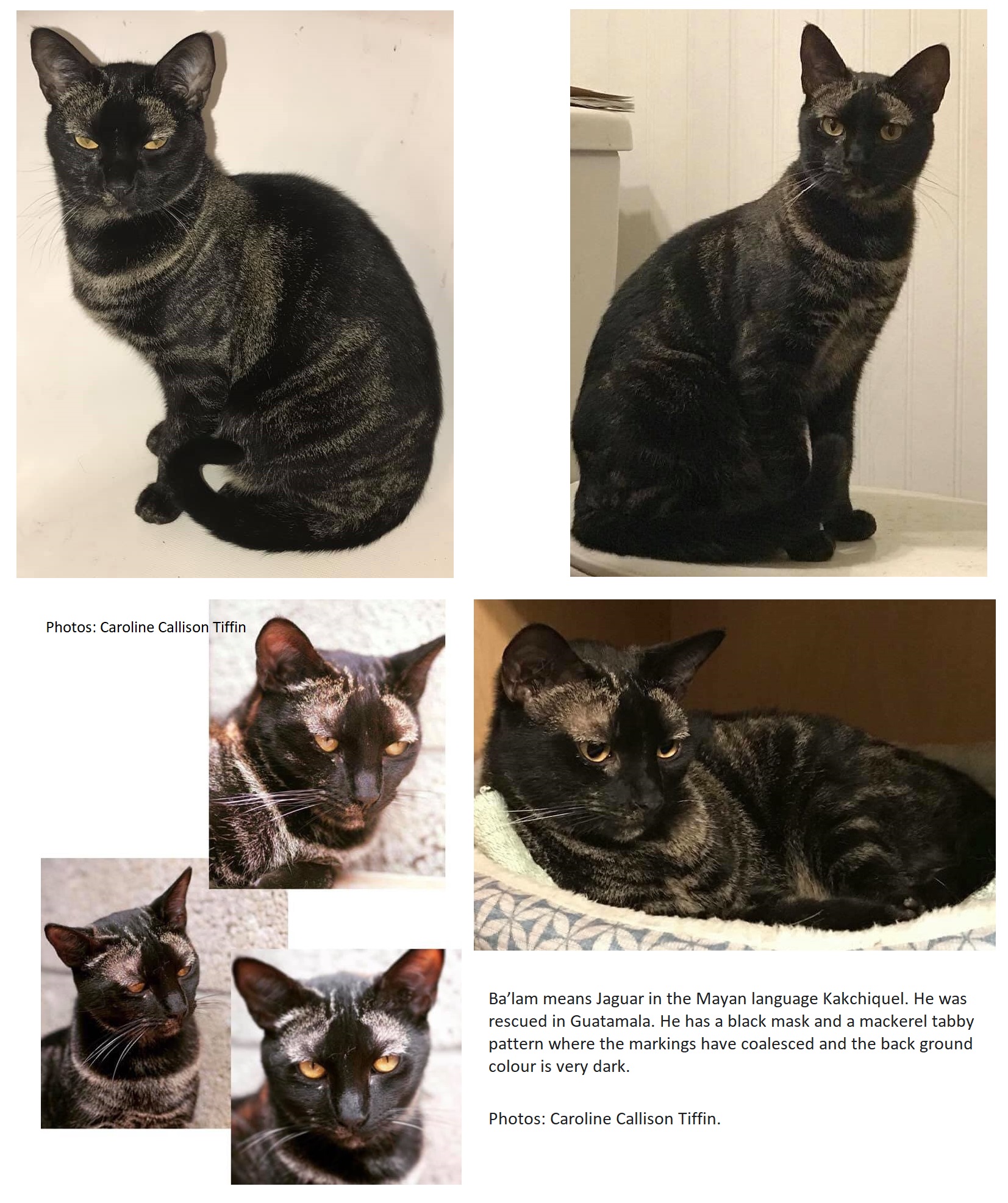
This tortoiseshell male is owned by Renato A. San Mateo, and appears to have case of chimerism (where 2 fertilized eggs fused and created a single embryo) - tortie males are unusual and are most commonly chimeras. One of the embryos seems to have had pseudomelanism (abundism) which is most evident on the face and chest.
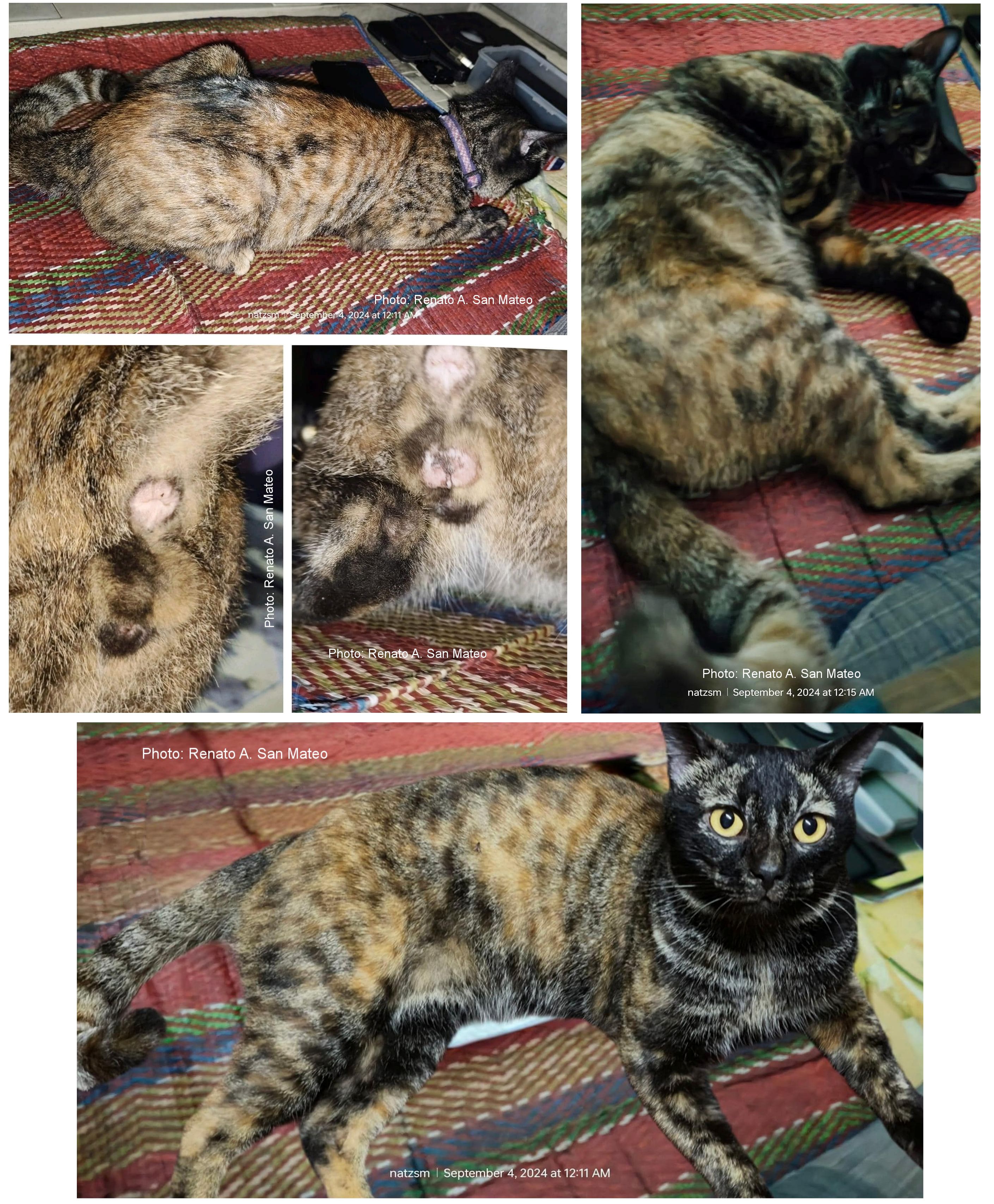
Jackie Newby (2025) also has a charcoal-like pseudomelanistic cat. In her younger years she cared for a large colony of cats on her property, either cats that chose her or cats that had been dumped nearby. She cared for them for over 20 years. Years later, she wanted a cat that was truly unique, and in May 2024, she found such a cat through Facebook Marketplace. A young woman needed to rehome him because her future was uncertain and though she loved the cat dearly, she couldn’t continue to care for him. This young woman had got him from a lady at 10 weeks old who had kept him locked in a bathroom without much interaction. Skully (a temporary name) was born on August 2nd. 2022 and is a gentle giant 3 times the size of Jackie's other cats. When he starts play running, it's like a locomotive running through the house. He grabs her hand to pull it back for more petting. He is described as the gentlest of souls and will get a permanent name that suits his uniqueness.
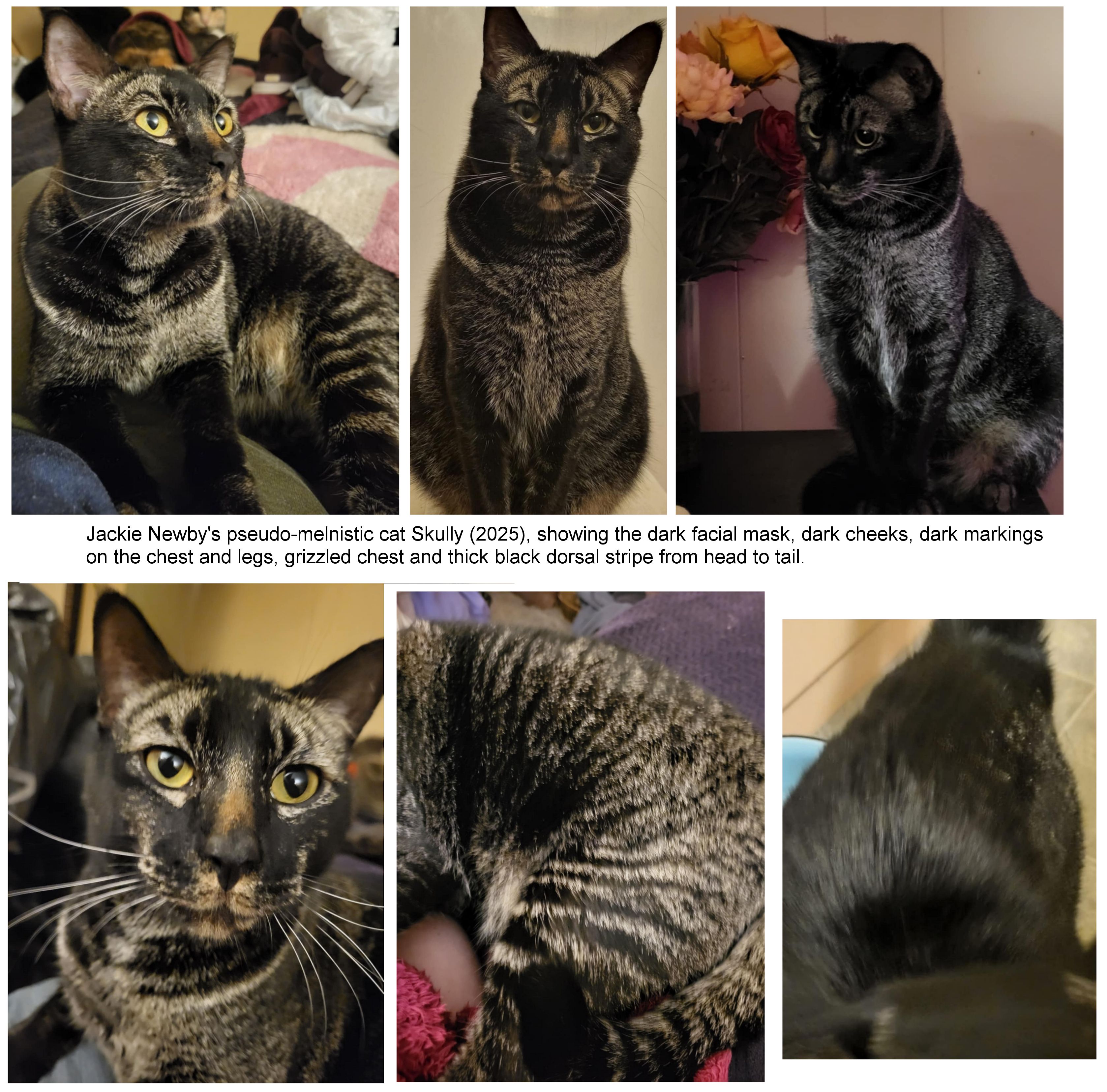
On February 1st 2025, one of my correspondents, Bailey, took in a foster from the local animal shelter, a one year old charcoal tabby named Ochi. On February 20th, Bailey adopted Ochi . Ochi’s history and ancestry is unknown.<.P>

RELATEDNESS
The family tree here shows the relatedness of Brandi's "Mystery Boy" and Jeanette Feather's black smoke Oriental Shorthair with breakthrough classic tabby pattern. The same breeding line has produced heavily marked classic tabbies. A mutation in the Taqpep gene (or its regulators) might produce unusually dense markings. A poorly functioning inhibitor (silver) gene in a genetically solid cat might produce a heavily patterned tabby cat instead of a smoke.

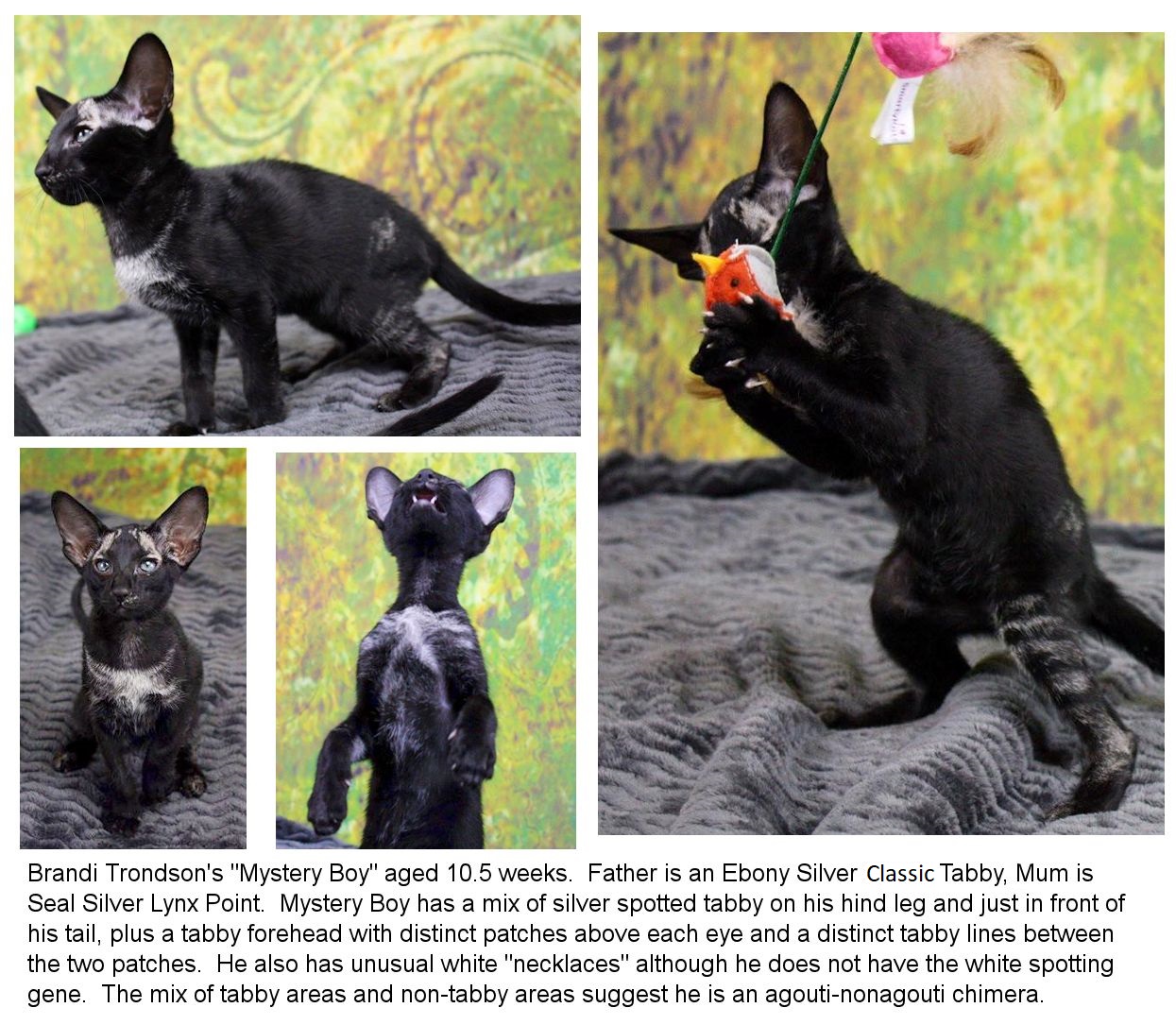
POSSIBLE CAUSES.
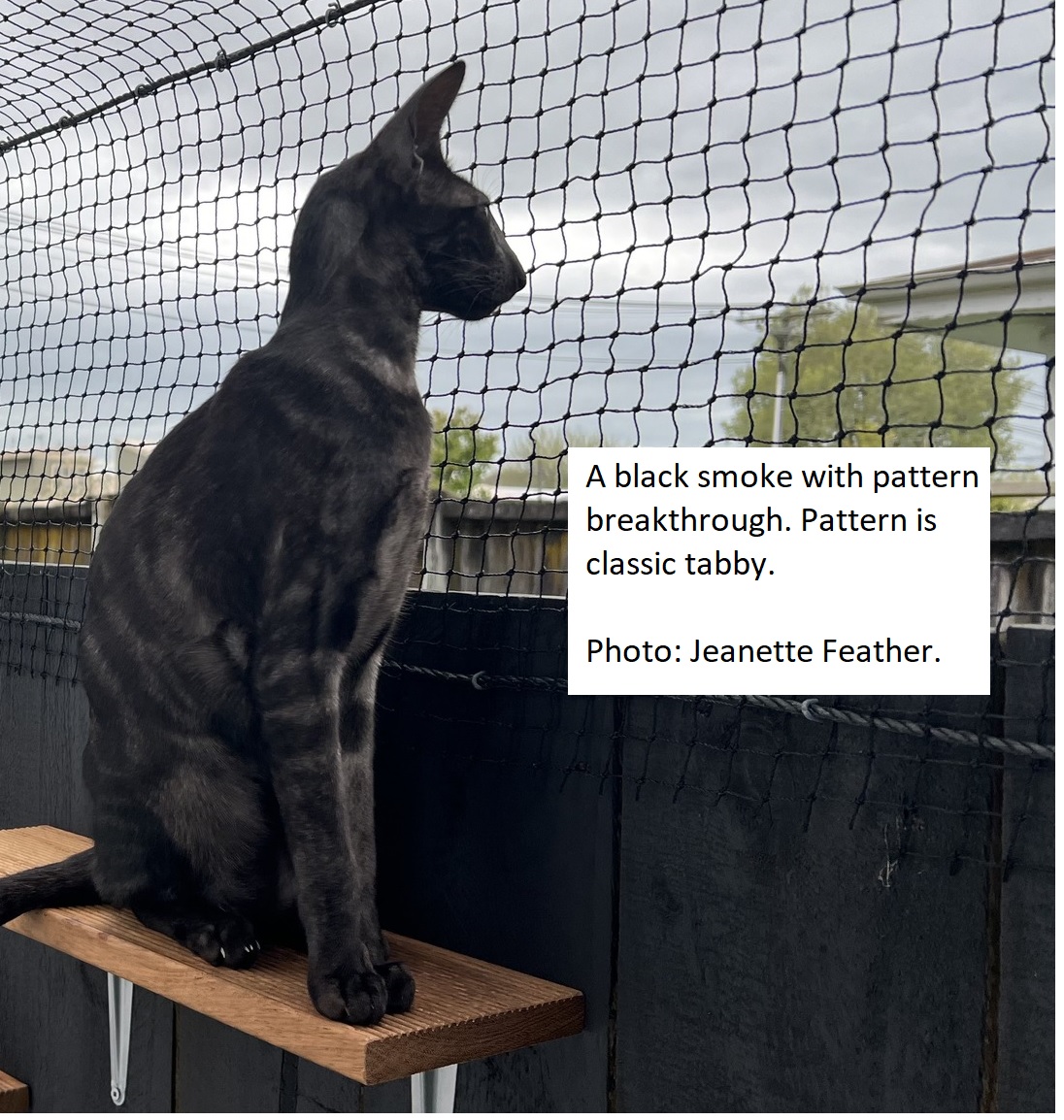
The pattern has turned up in different parts of the world, and in purebred and random-bred cats, so it can't be from a single common ancestor. Most likely there are different causes that give this visual effect.
(1) Escape of the charcoal pattern (AsipPb mutation) into the random-bred gene pool. Only a few have the typical charcoal pattern and this theory would involve multiple escapes in multiple areas. Not all pseudomelanistic cats have the typical charcoal pattern.
(2) An agouti gene mutation so that the gene is only partially functioning; ticked hairs develop as solid colour hairs allowing the normal tabby markings to coalesce. Only a little of the background colour remains, primarily on the chest and underparts, hence the colloquial term "sheeted tabby." This can occur with any tabby or spotted pattern. Spots coalesce into swirls; stripes coalesce into solid areas.
(3) Taqpep gene mutation (or mutation of gene(s) that regulate taqpep, causing tabby markings to coalesce.
(4) Breakthrough pattern in smoke cats (similar to smoke Egyptian Maus). Whatever regulates the silver gene might also affect in taqpep.
(5) Chimeras of solid black and black tabby embryos. This would account for only a few cats.
(6) Environmental factors affecting pigmentation.
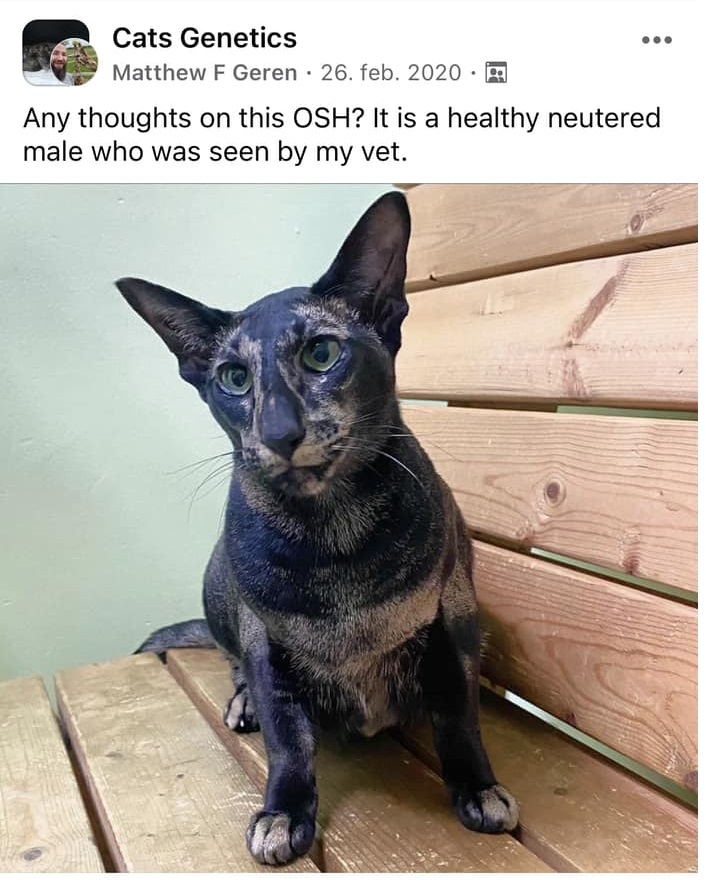
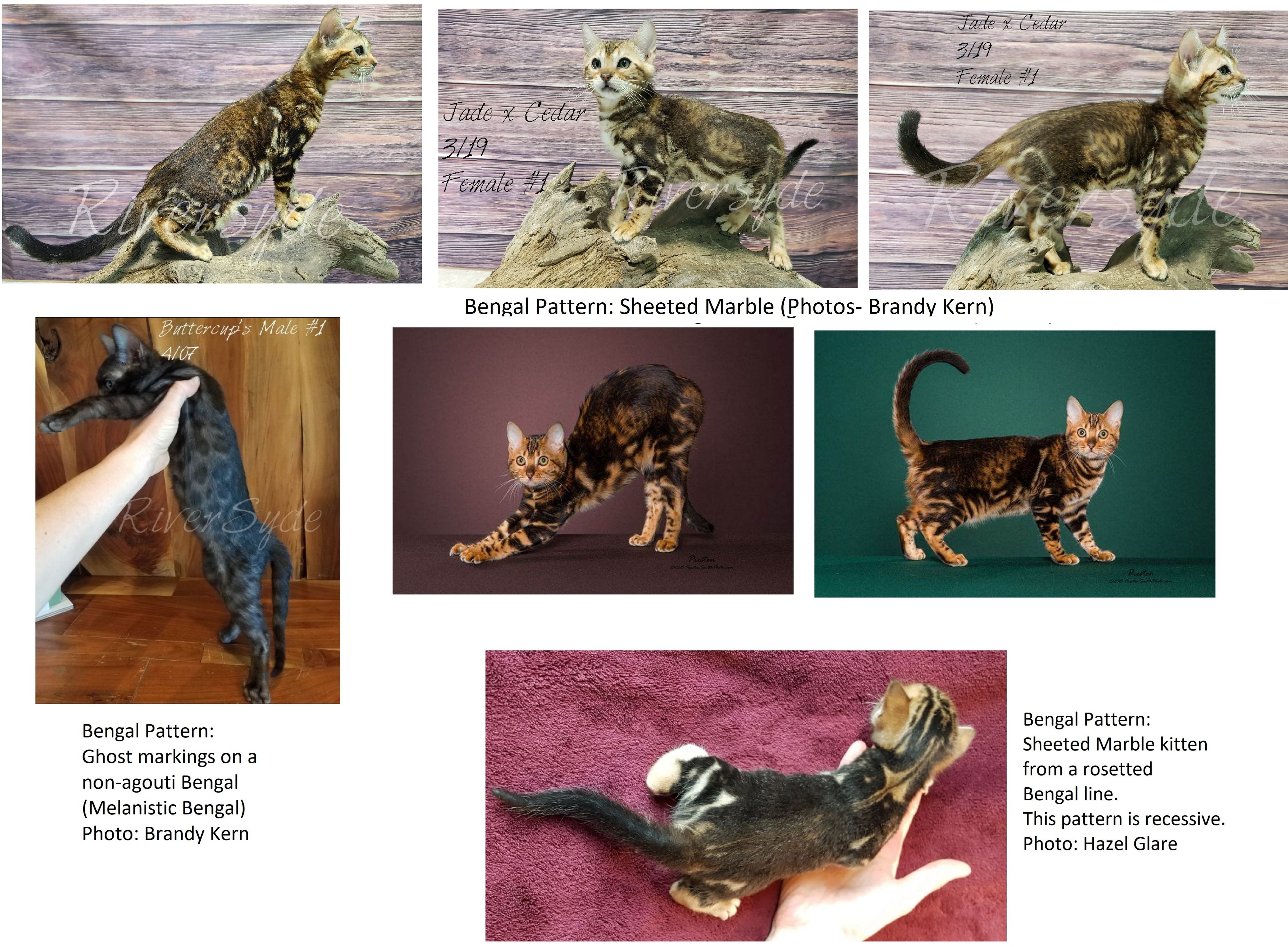
CHARCOAL PATTERN (BENGAL & RELATED BREEDS)
In Bengal and Savannah cats, Charcoal is a modification of the tabby pattern, rather than a separate colour hence there are Charcoal Brown, Charcoal Silver and Charcoal Snow combinations. Interaction of Asian Leopard Cat (ALC) and domestic cat genes produces partial melanism where the markings are black or nearly-black and flow into one another. The dorsal stripe is wider and there is a distinctive dark mask on the face and nose. Several small wildcats have a rufous morph and a greyish morph (local adaptations to different environments in their range) and this has emerged in the Bengal breed. It is probably most striking on the Snow Bengals. Charcoal originated in the Bengal breed through a gene found in the Asian Leopard cat. It has also been found in the Savannah cat, introduced there by the Bengal. It was particularly seen in early generation Bengals.

Charcoal in Bengals is due to an Asian leopard Cat agouti gene variant interacting with domestic cat tabby genes. This increases the black pigmentation unevenly throughout the coat. The distribution of pigmentation varies between cats. Charcoal tabbies typically have "Zorro" markings with white goggles around the eyes and a dark "charcoal mask" from the forehead, down the nose-bridge and often underneath the eyes; this resembles an upside-down "Y". Charcoals also have an unbroken "cape" or "sheet" down their backs.
The Bengal marble pattern has horizontally flowing markings which may be hollow with a deeper version of the base colour in the centre (clouding). Interaction with domestic cat pattern genes produced a number of variations on the marbled them. Denser, larger markings produce the "sheeted" marble pattern: a heavily marked pattern with a sheet or cape along the back; the markings have ragged edges and little background colour is visible between them. This pattern tends to open up as the cat reaches maturity.
Charcoal is associated with the ALC version of the Agouti Signalling Protein (Asip) gene. The charcoal pattern has never been reported in the ALC, even if they are homozygous for the mutation. It is only when the ALC version interacts with domestic cat genes that the charcoal pattern appears.
- AsipPb - Asip from leopard cat (ALC-Asip, Pb = Prionailurus bengalensis) - 4 different variants of AsipPb have been identified so far.
- AsipPb/AsipPb (homozygous) can be charcoal OR non-charcoal (for example, AsipPb1/AsipPb1 may look different from AsipPb1/AsipPb2 or AsipPb2/AsipPb2)
- AsipFc - Asip from domestic cat (Fc = Felis catus)
- Asipa - domestic cat non-agouti gene ("self colour" when homozygous (Asipa/Asipa))
- Melanocortin 1 receptor (Mc1r) encodes the receptor for Asip.
- AsipPb/Asipa (i.e. heterozygous) gives charcoal.
Charcoal Bengals tend to be either homozygous for ALC-Asip (AsipPb/AsipPb) or heterozygous for ALC-Asip + a domestic cat non-agouti allele (AsipPb/Asipa).
Non-charcoal Bengals that are AsipPb/AsipPb tend to have greater contrast in their markings than those that don't have 2 copies of the ALC version of the gene.
The reason AsipPb/AsipPb cats could be either charcoal or non-charcoal is probably due to which of the AsipPb mutations they have and how these interact with each other.
Bengals with the ALC version of Mc1r had the same charcoal pattern as their siblings with the domestic cat version of Mc1r. This means ALC-Mc1r does not affect the charcoal pattern.
Charcoal appears to be due to reduced expression of a normal leopard cat Asip gene in a domestic cat background. There are 5 distinct AsipPb haplotypes in the Bengal, each of which can cause charcoal. Each haplotype comes from an independent introgression event from a different ancestral leopard cat chromosome. (A haplotype is a group of genes that are inherited together from a single parent.)
In heterozygous AsipFc/AsipPb cats there was reduced expression of the AsipPb allele, probably due to a mismatch between domestic cat transcription factors and ALC regulatory elements. Gene regulatory incompatibilities may contribute to selection against other ALC genes in the Bengal cat genome.
- Christopher B. Kaelin, Kelly A. McGowan, Anthony D. Hutcherson, John M. Delay, Gregory S. Barsh, "Ancestry dynamics and trait selection in a designer cat breed," December 12, 2022,